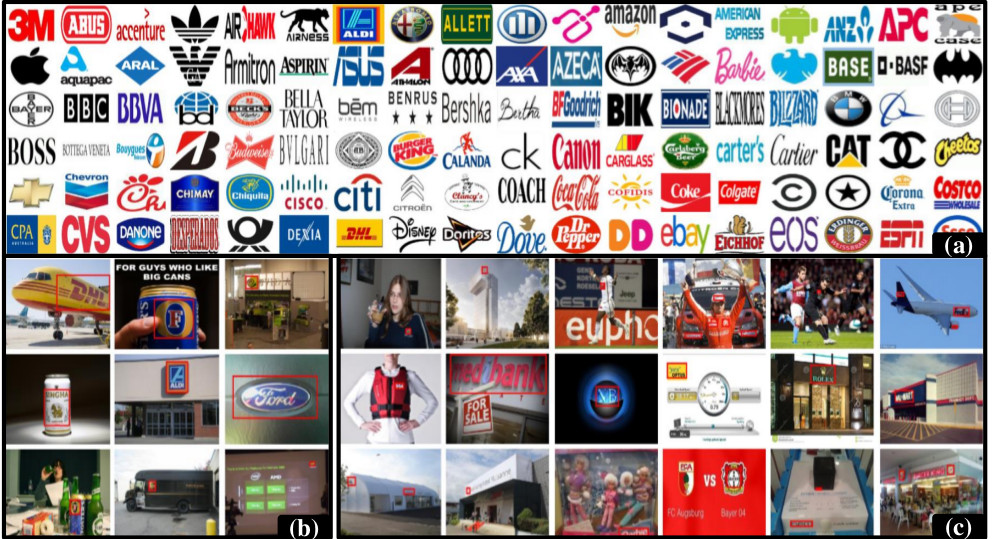QMUL-OpenLogo: Open Logo Detection Challenge

Description
Existing logo detection benchmarks consider artificial deployment scenarios by assuming that large training data with fine-grained bounding box annotations for each class are available for model training. Such assumptions are often invalid in realistic logo detection scenarios where new logo classes come progressively and require to be detected with little or none budget for exhaustively labelling fine-grained training data for every new class. Existing benchmarks are thus unable to evaluate the true performance of a logo detection method in realistic and open deployments. In this work, we introduce a more realistic and challenging logo detection setting, called Open Logo Detection. Specifically, this new setting assumes fine-grained labelling only on a small proportion of logo classes whilst the remaining classes have no labelled training data to simulate the open deployment. Further, we create an open logo detection benchmark, called QMUL-OpenLogo, to promote the investigation of this new challenge. QMUL-OpenLogo contains 27,083 images from 352 logo classes, built by aggregating and refining 7 existing datasets and establishing an open logo detection evaluation protocol.
Statistics
For dataset training-evaluation split, we propose 3 kind of setting. The first one is the fully supervised setting, with every logo classes contains 70% of training split and 30% of evaluation split. The second setting split the dataset into 32 supervised classes and 320 unsupervised classes, where the supervised contains real training split and evaluation split, while the unsupervised classes have no training split, only evaluation split. For the 3rd setting, we split the dataset into 176 supervised classes and 176 unsupervised classes.
Notification for Supervised/Unsupervised splitting: The dataset contains images of multi-instances and multi-classes, thus some supervised set images may contain both supervised and unsupervised instances in it, it is recommendded to filter it for own useage.
Closed-set logo detection setting: all logo classes have training images.
| Classes | Train Images | Val Images | Test Images | Total Images |
|---|---|---|---|---|
| 352 | 15,975(59.0%) | 2,777(10.3%) | 8,331(30.7%) | 27,083 |
Open-set logo detection setting 1: only a msall proportion of logo classes have training images.
| Type | Classes | Train Images | Val Images | Test Images | Total Images |
|---|---|---|---|---|---|
| Supervised | 32 | 1,280(11.2%) | 1,023(8.9%) | 9,168(79.9%) | 11,471 |
| Unsupervised | 320 | 0 | 0 | 15,612 | 15,612 |
| Total | 352 | 1,280(4.7%) | 1,023(3.8%) | 24,780(91.5%) | 27,083 |
Open-set logo detection setting 2: Half of the logo classes have training images and the other half have no training images.
| Type | Classes | Train Images | Val Images | Test Images | Total Images |
|---|---|---|---|---|---|
| Supervised | 176 | 10,586(59.3%) | 1,561(10.2%) | 3,121(20.5%) | 15,268 |
| Unsupervised | 176 | 0 | 0 | 3,649 | 3,649 |
| Total | 352 | 10,586(56.0%) | 1,561(8.2%) | 6,770(35.8%) | 18,917 |
News
- March 4, 2019: Baidu cloud download link provided
- Feb 19, 2019: Tencent cloud download link provided
- Nov 7, 2018: Leaderboard introduced
- July 03, 2018: Dataset released.
Download
QMUL-OpenLogo Dataset (4.7 GB): [Google Drive] [Baidu Cloud] [Tencent cloud]
Supplyment Imageset List for OpenLogo Semi-Supervised Challenge Setting 1: [Google Drive]
Supplyment Imageset List for OpenLogo Semi-Supervised Challenge Setting 2: [Google Drive]
Supplyment Imageset List for OpenLogo Closed Set Fully-Supervised Challenge: [Google Drive]
Clean Logo Exemplars: [Google Drive]
Citation
Open Logo Detection Challenge. Hang Su, Xiatian Zhu and Shaogang Gong. In Proc. British Machine Vision Conference (BMVC), Newcastle, UK, September 2018. BibTex arxiv
Related Datasets
- FlickrLogo-32
- WebLogo-2M
- TopLogo-10
- Flickr Logo 27
- Logo32plus
- BelgaLogos
- Logos-In-The-Wild
- SportsLogo
Licence
Please notice that, the QMUL-OpenLogo Dataset is made available for academic research purpose only. All the images were collected from the existing logo detection datasets, and the copyright belongs to the original owners.
Contact
Please feel free to send questions/comments/results(to be added in Leaderboard) to Hang Su at 9175ak@gmail.com